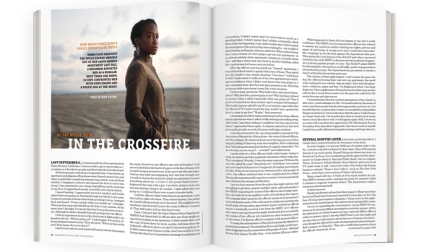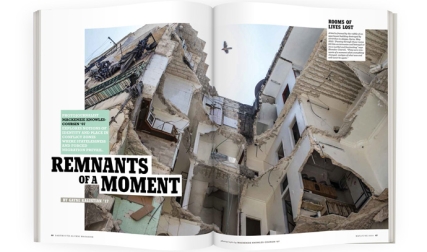View full article with images of Stromeyer’s sculptures in the DAM archive.
Turning sheets of cold steel into the massive, free-flowing works of sculpture that twist, fold and glide across the rolling meadows of David Stromeyer’s 200-acre Vermont property requires meticulous judgment, an acutely nuanced understanding of the material and feats of near-Herculean physical effort that he chooses to downplay. “You just bring a bit of force to it, that’s all,” he says.
In a world-class fabrication studio he built, with tools and machinery of his own unique crafting, Stromeyer, 69, creates structures that make the most rigid materials appear fluid. “Most people think of steel as the stiff parts that hold buildings up,” he says. “And it’s good for that too, I suppose.”
Stromeyer likes to “challenge” his materials (mostly steel) and push them into forms so structurally ambitious that they sometimes appear to defy physical limits. Occasionally when he’s working on a public project—he’s executed commissions for fees in excess of $100,000—Stromeyer is asked to have an engineer approve his plans to comply with local building codes. “They throw up their hands,” he says. Engineers will try to calculate mathematically what he knows intuitively about the nature of steel. “I don’t do those calculations,” says the artist. “After 45 years of watching steel bend I can look at a piece of steel and know what it’s willing to do.”
He uses the word “willing” advisedly. Stromeyer anthropomorphizes his work, describing his artistic process as a dialogue between himself and the metals he’s manipulating. He negotiates, asking how much bending, twisting and stretching the material can sustain before its plastic limit is reached. “I apply these extreme forces and I say, ‘Do you think you can pull this off?’ and when the answer is ‘No,’ therein lies the challenge,” he explains.
Stromeyer’s pieces, alternatively shouting with bright color and quietly blending in with their surrounding landscapes (through the course of his career he has shifted from using weathered materials to painting his sculptures), have been featured on exhibition at such locations as the Emerson Umbrella Center for the Arts in Concord, Massachusetts, and the Johnson Museum of Art at Cornell University. Many of his pieces are on permanent display throughout the country, including a small, crimson piece called Southwest Sunset that can be viewed at the Smithsonian American Art Museum in Washington, D.C.
“What is surprising about David Stromeyer’s sculpture is the way it exists in the landscape. More specifically, the way it exists in the Vermont landscape,” wrote curator Christopher Thompson in the introduction to Stromeyer’s 2012 career retrospective at Burlington (Vermont) City Arts Center. “Undeniably his works are monolithic. At 10, 15, 20 feet high, their scale only becomes apparent when you are directly adjacent to them. It is also only in this close proximity that the weight of their construction—welded, cold-bent, half-ton steel plates—becomes apparent. Their colors belie the mass. Their fluorescent forms seem to float across the fields like the autumn leaves that Vermont is so well known for.”
Muscular and weathered from working outdoors, and bearing the scars of physical wear sustained while manipulating heavy, rigid materials, the sculptor underwent reconstructive surgery a decade ago to reverse tissue damage inflicted on his hands and thumbs during his career. Stromeyer has always been something of a handyman. He spent his boyhood in Marblehead, Massachusetts, tinkering—always working with his hands, whether constructing model airplanes, forts or rope swings. He followed his older brother, Charles ’64, to Dartmouth, planning to major in math and compete on the ski team. By his senior year he had found a home in the studio arts department, a transition he describes as part of a natural shift.
“Math, in its pure form, is among the most abstract of the sciences,” he says. “So if you like math, you embrace that kind of abstract thinking, and it follows to me very clearly that you would respond to abstraction in other forms.” Stromeyer didn’t leave his left-brain prowess behind as he made moves into the world of visual art. His creative work interfaces with chemistry, physics, engineering and mechanical sciences at every stage, from the shaping of the metal—a process aided by a 150-ton hydraulic press that he built—to the sandblasting and painting of his pieces to their final installations.
After graduation, having created several of his own films and dabbled considerably in sculpture, Stromeyer took a film-editing job with a Boston-based company and worked as a freelance museum photographer in his free time. Inspired by the works of sculptors David Smith and Mark di Suvero, he also began creating sculptures with steel harvested from metal scrap yards. He and friend Wayne Wadhams ’68, who specialized in scoring movies, started their own film company but couldn’t make a go of it.
“I wasn’t quite happy with the direction things were going,” he says, “and sculpture was always sort of in the back of my head, so I decided, ‘I need to think about all this,’ and I got on my bicycle and I pedaled north.”
He fashioned a pair of bicycle pants by sewing leather patches onto his corduroys and biked from Boston to Quebec City to Montreal, where he hopped a train to Edmonton and proceeded to pedal and hitchhike his way to Berkeley, California, where he met up with Charlie Gay ’68. Together they hitchhiked eastward, and before long Stromeyer found himself back in the forests of northern New England, a setting that inspires his work.
“I liked Vermont, the northern half, very much,” he says. He purchased his Enosburg Falls property, formerly a dairy farm, in 1970. Nestled in the foothills of the Cold Hollow mountain range, the land appealed to him because of its “perfect” balance of forest and meadow landscape, beautiful contours and magnificent views of the mountains.
He made his home in a former horse barn on the property, and within the first year started building a sculpture studio up the hill. He named his operation Cold Hollow Iron Works, in part as homage to David Smith’s much-lauded Terminal Iron Works studio.
Although he now spends winters in Austin, Texas, which appeals to him as a growing center of cultural vibrancy, Stromeyer continues to find inspiration in the Vermont landscape and in the extreme nature of New England weather. “The changing environment and the changing light is a big factor in my thinking, particularly with color, about how a piece will take shape—about where I’ll put it and how it will read,’’ he says.




